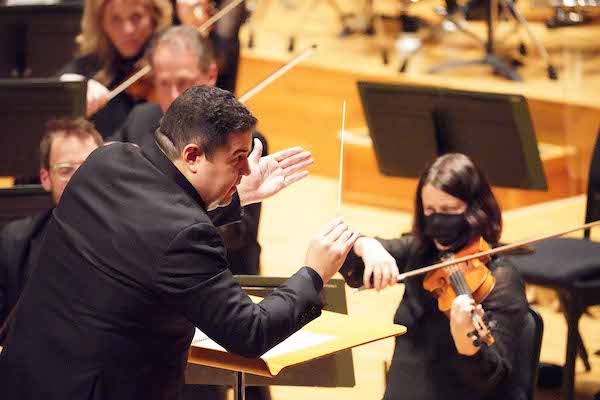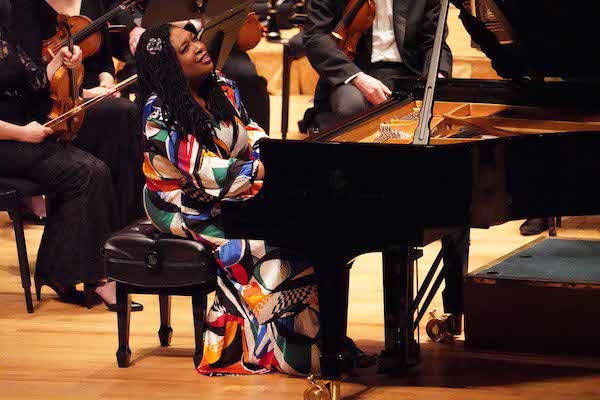Utah Symphony goes from light and jazzy to dark Russian drama
A year after making his Utah Symphony debut, Tito Muñoz returned to conduct an eclectic program featuring pianist Michelle Cann and two local premieres: Florence Price’s Concerto in One Movement and Gabriela Lena Frank’s Elegia Andina.
Inspired by a trip to Peru, Frank’s Elegia is a colorful, rhythmically intoxicating dance, lightly evoking Peruvian folk music and using the orchestra in interesting ways to create distinctive sonorities. In addition to a pulsating pizzicato undergirding much of the piece, the strings produced bird-like sounds by lightly “ghosting” their bows across their strings.
At the center of the piece is an exposed, contrapuntal flute duet, which, the composer explained in her notes, was meant to simulate the Peruvian zampoña pan flutes. Associate principal Lisa Byrnes and section flute Caitlyn Valovick Moore delivered a spacious rendering of this duo cadenza, as their melodies intertwined to captivating effect.
Muñoz drew dynamic swells and crisp cut-offs to the short phrases, displaying the conductor’s flair for phrasing and dynamic architecture.
Michelle Cann, a professor of piano at the Curtis Institute of Music, has devoted much of her career to championing Florence Price’s music, particularly the Concerto in One Movement. Following its premiere with the Chicago Symphony Orchestra in 1934, the work was not heard again until Cann gave its New York City premiere in 2016.
Concerto in One Movement is something of a misnomer, as the piece has three distinct, self-contained sections in distinct styles, and the performance showcased Cann’s technique, musicality, and charisma in her Utah Symphony debut.
The first section sounds like a Romantic concerto in the style of Rachmaninoff or Grieg, but with a hint of melodic flavoring from the Great American Songbook. After a brief call-and-response fanfare in the brass and winds, the piano enters with a virtuosic run that builds into an extended thematic statement. Cann entered authoritatively and infused the passage with passion. Her powerful tone and communicative phrasing commanded attention, and when Muñoz and the orchestra entered again, they reflected her interpretation back to her with a full, shimmering sound.
In the slow second section, the piano melody is built on a bluesy pentatonic scale. Cann gave a soulful shape to the thick, resonant harmonies, taking her time to build each phrase, and again, Muñoz followed her interpretive lead, giving the rich orchestral sonorities transparency and time to breathe.
The sparkling third movement is overt ragtime and swing, though of a gentler stripe than Gershwin. Cann and the orchestra played off one another well, infusing the piece with a natural swing, which built to a big, boisterous finish. The resulting standing ovation was replete with cheers and enthusiastic applause. As an encore, Cann played Hazel Scott’s brilliant jazz arrangement of Rachmaninoff’s Prelude in C sharp Minor, which, like the Price concerto, showcased her unique strengths.
The second half of the concert marked a dramatic shift in tone with a powerful rendition of Shostakovich’s anguished Symphony No. 10.
Muñoz’s spoken introduction to the Shostakovich was a bit rambling and unfocused, but it did shed light on his own interpretation of the piece, which he described in much the same way as annotator John Mangum: “48 minutes of despair, terror, and violence and two minutes of triumph.”
Indeed, Muñoz’s rendition, though masterful and precise, emphasized the piece’s bleakness. It began slowly and severely, with a meticulously phrased passage in the low strings followed by the entry of the rest of the strings with a sawing, nearly vibrato-less tone. As the orchestra built slowly to its first climax, the tone remained dark and serious, with passages that could be interpreted as playfully ironic coming off as bitter.
Muñoz infused the second movement, said to represent Stalin himself, with a frightening energy and relentless rhythmic drive. The orchestra acquitted itself well through the breathtakingly fast passages, and Muñoz managed the energy well with crisp attacks and a clear rhythmic pulse.
The third movement showcased principal horn Jessica Danz’s tone and musicality in an exposed and deeply poignant solo passage. This contrasted with a rollicking sardonic waltz in which Muñoz unleashed the full sound of the orchestra. The fourth movement also featured contemplative and well-phrased solo passages from principal oboist Zac Hammond and principal flutist Mercedes Smith before the piece gave way to the frenetically churning that leads to the eventual triumph. Muñoz kept the orchestra together and maintained the piece’s pulse and dynamic through-line to the blazing coda.
The program will be repeated 7:30 p.m. Saturday. utahsymphony.org


Posted Apr 15, 2023 at 3:09 pm by vladimir
Wonderfull concert. Thank you for writing such eloquent and vibrant prose about it.